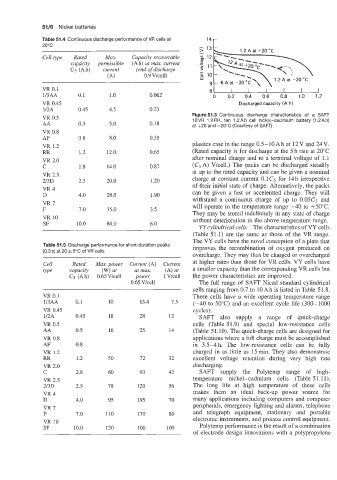Page 558 - Battery Reference Book
P. 558
51/6 Nickel batteries
Table 51.4 Continuous discharge performance of VR cells at l4 r
20°C
1.2 A at +20 "C
Cell type Rated Max. Capacity recoverable
capacity permissible (Ah) at man. current
C5 (Ah) current (end of discharge
(A) 0.9 V/cell)
1.2 A at -20 "C
VR 0.1 81 1 I I I I I
113AA 0.1 1 .o 0.062 0 0.2 0.4 0.6 0.8 1.0 1.2
VR 0.45 Discharged capacity (A h)
1/2A 0.45 4.5 0.23
Figure 51.3 Continuous discharge characteristics of a SAFT
VR 0.5 10 VR 1.2 RR, ten 1.2 A h cell nickel-cadmium battery (1.2 A h)
AA 0.5 5.0 0.18 at f20 and -20°C (Courtesy of SAFT)
VR 0.8
AF 0.8 8.0 0.35
VR 1.2 plastics case in the range 0.5-10Ah at 12V and 24V.
RR 1.2 12.0 0.65 (Rated capacity is for discharge at the 5 h rate at 20°C
VR 2.0 after nominal charge and to a terminal voltage of 1.1
C 1.8 14.0 0.87 (C5A) Vkell.) The packs can be discharged steadily
VR 2.5 at up to the rated capacity and can be given a nominal
2/3D 2.5 20.0 1.20 charge at constant current 0.1Cj for 14h irrespective
VR 4 of their initial state of charge. Alternatively, the packs
D 4.0 28.0 1.90 can be given a fast or accelerated charge. They will
withstand a continuous charge of up to 0.05Cj and
VR 7
F 7.0 35.0 3.5 will operate in the temperature range -40 to +50"C.
They may be stored indefinitely in any state of charge
VR 10 without deterioration in the above temperature range.
SF 10.0 80.0 6.0
Wcylindrical cells The characteristics of VY cells
(Table 51.1) are the same as those of the VR range.
The VY cells have the novel conception of a plate that
Table 51.5 Discharge performance for short-duration peaks improves the recombination of oxygen produced on
(0.3 s) at 20 & 5°C of VR cells
overcharge. They may thus be charged or overcharged
Cell Rated Max. power Current (A) Current at higher rates than those for VR cells. VY cells have
type capacity (W) at atmax. (A) at a smaller capacity than the corresponding VR cells but
Cj (Ah) 0.65 Vkell power 1 Vlcell the power characteristics are improved.
0.65 V/cell The full range of SAFT Nicad standard cylindrical
cells ranging from 0.7 to 10 Ah is listed in Table 51.8.
VR 0.1 These cells have a wide operating temperature range
1/3AA 0.1 10 15.4 7.5 (-40 to 50°C) and an excellent cycle life (300-1000
VR 0.45 cycles).
1/2A 0.45 18 28 12 SAFT also supply a range of quick-charge
VR 0.5 cells (Table 5 1.9) and special low-resistance cells
AA 0.5 16 25 14 (Table 51.10). The quick-charge cells are designed for
VR 0.8 applications where a full charge must be accomplished
AF 0.8 in 3.5-4h. The low-resistance cells can be fully
VR 1.2 charged in as little as 15min. They also demonstrate
RR 1.2 50 72 32 excellent voltage retention during very high rate
VR 2.0 discharging.
C 2.8 60 93 42 SAFT supply the Polytemp range of high-
VR 2.5 temperature nickel-cadmium cells (Table 5 1.1 1).
2/3D 2.5 78 120 56 The long life at high temperature of these cells
VR 4 makes them an ideal back-up power source for
D 4.0 95 195 70 many applications including computers and computer
VR 7 peripherals, emergency lighting and alarms, telephone
F 7.0 110 170 80 and telegraph equipment, stationary and portable
VR 10 electronic instruments, and process control equipment.
SF 10.0 130 100 100 Polytemp performance is the result of a combination
of electrode design innovations with a polypropylene

